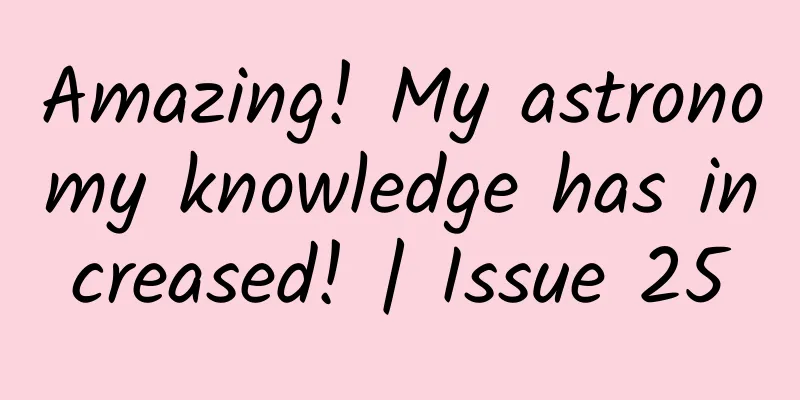Amazing! My astronomy knowledge has increased! | Issue 25

|
Facing the unknown universe, Human beings are always curious children. "Wow, my astronomy knowledge has increased!" [Issue 25] Q1: Wanling Louise [Question] Why do some stars have rings and some don’t? A: When talking about planetary rings, the first thing people think of is probably Saturn with its own halo. After all, this image is so classic that it is deeply rooted in people's hearts. Saturn with its rings, this is the desktop screensaver I use myself, generated by SpaceEngine / Xu Penghui What is certain is that among the eight planets in the solar system, Saturn is not the only one with planetary rings. In addition to Saturn, Jupiter, Uranus, and Neptune also have their own planetary rings, but their planetary rings are relatively faint and difficult to detect. In contrast, the four rocky planets (Mercury, Venus, Earth, and Mars) have not been found to have planetary rings. A backlit photo of Neptune's rings. This photo was stitched together from two photos taken by Voyager 2 in 1989. Because Neptune's rings are so dark, the overly bright Neptune itself had to be moved out of view when taking the photo, and the rings on both sides were photographed separately. / Internet What is the reason for this difference? Scientists speculate that the formation of planetary rings is related to the mass and gravity of the planet itself. Planets with larger masses, such as Jupiter, Saturn, Uranus, and Oceanus, have stronger gravity. On the one hand, this will help them attract more interplanetary matter as the material basis for the formation of planetary rings; on the other hand, greater mass and gravity give them a larger Roche limit radius. Within the Roche limit radius, intact stellar matter such as satellites will not be able to maintain its shape under the tidal effect of the planet and will be torn apart, forming a belt of debris surrounding the planet. Taking Saturn's rings as an example, one speculation is that Saturn's rings were formed by Saturn using its own huge mass to accrete matter in the interplanetary space. Another major speculation is that Saturn's rings originated from a broken Saturn satellite. An earlier version of this speculation believes that Saturn's rings may have been formed by a satellite similar to Mimas that was completely broken after multiple collisions. Another newer version believes that this possible satellite was swallowed by Saturn during the formation of Saturn, but during the swallowing process, the icy mantle of this satellite was gradually pulled out of the main body of the satellite, forming a ring-shaped material belt, which later evolved over a long period of time to form today's Saturn rings mainly composed of water ice. J1407b's giant planetary rings, generated by SpaceEngine / Web But the new discovery suggests that planetary rings may have different formation mechanisms. In 2007, scientists discovered that the star J1407 had an unusual transit phenomenon, and then in 2012, scientists confirmed the existence of the exoplanet J1407b and its planetary ring through a detailed interpretation of relevant observational data. What is surprising is that this planet actually has a planetary ring with a radius of 0.6 AU. Such a huge ring radius has obviously exceeded the Roche limit radius of the planet, and according to scientists' interpretation of the observational data, it seems that satellites are being formed in the planetary ring. This suggests that planetary rings may not be stable relative to the entire life cycle of the planet (a time scale of billions of years), and their formation and disappearance is a dynamic process. Haumea with its rings. The aspect ratio of the image is not compressed. Haumea is indeed egg-shaped. The image was generated by SpaceEngine/Internet In addition to planets, scientists have also discovered that some asteroids also have their own rings. Haumea, 10199, 2060, and other celestial bodies have also been found to have ring structures, but the gravity of these small celestial bodies is obviously not enough to tear apart other celestial bodies near them. These discoveries have cast a new veil on the rings, suggesting that we may have unknown mechanisms for the formation of rings. [Intelligent robot: You asked me why I also... (sigh)] Q2: Lin Bingguo [Question] How were Saturn's rings formed? If it is due to gravity, then why are there gaps? A: We have just talked about the formation mechanism of planetary rings. Here we will mainly explain the causes of the gaps in Saturn's rings. One cause is the orbital resonance of satellites. The most typical example of orbital resonance is the effect of Jupiter on the semi-major axis distribution of asteroids in the asteroid belt: asteroids whose orbital periods are integer ratios to Jupiter's orbital period will be periodically affected by Jupiter's gravity, and will be pulled out of their original orbits and unable to operate stably. This effect also exists in Saturn's rings. The famous Cassini gap is the "masterpiece" of Mimas. The location of this gap has an orbital period that is exactly half of Mimas. Cassini Gap, Encke Gap and Saturn, generated by SpaceEngine / G. Cataldo, 2015 Another cause is the direct cleaning of satellites. There are also satellites of Saturn in the rings of Saturn. Some satellites will use their own gravity to clean up the Saturn ring material in their orbits, leaving a gap. The Encke Gap was cleaned up by Saturn's moon Saturn XVIII. [Intelligent Robot: The little satellite has a good appetite~] Q3: Yang Ming from outside [Question] Why is there such a huge difference in the ratio of width to thickness of Saturn's rings? A: The width of Saturn's rings is about 100,000 kilometers (some studies show that it may be larger), while its thickness is only 10 meters, a difference of nearly 10 million times. To understand the reason for such a huge difference in width-to-thickness ratio, we may be able to see what would happen if Saturn's rings were much thicker than they are now. If the current Saturn rings are thickened - for example, 100-1000 kilometers - and assuming that they do not gather into satellites, Saturn's rings will become a "donut" shape. Since this circle of things rotates with the center of Saturn as the center, the fragments outside the center plane of the "donut" will inevitably pass through the center plane periodically. In addition, because the matter in the "donut" is approximately evenly distributed, these fragments will collide while constantly passing up and down the center plane. Over time, the fragments on both sides of the center plane will cancel each other's longitudinal velocity components due to collisions. Finally, most of the fragments will concentrate their orbits on the center plane, forming an extremely flat planetary ring. (This process should have been accompanied by a picture, but SpaceEngine does not have the function of generating natural objects, so I can't draw it, so I have to trouble the editor to provide a picture. Remember to delete the content in the brackets later) ((இдஇ; ) I can't draw thick either, can I put a few donuts in it?) Of course, in addition to the fact that the characteristics of the planetary rings themselves determine that they are not very thick, some of the Saturn satellites mentioned above also play the role of "shepherds" to a certain extent, maintaining the basic shape of Saturn's rings and preventing them from spreading inward or outward. Due to the collision of particles in the rings, the planetary rings themselves naturally have a tendency to spread inward and outward, and the satellites located on the inside or outside of the rings can use their own gravity to push the particles on the inside of the ring outward or push the particles on the outside of the ring inward, thereby helping to maintain the shape. For example, Saturn's moons Saturn and Saturn's moons are the "shepherd satellites" of the F ring. Prometheus, Pantheon and the F ring (the thin line between the two satellites), generated by SpaceEngine / SpaceEngine [Intelligent robot: meow~] Q4: Yang Ming from outside [Question] Why are Saturn's rings the only one as big as Saturn's among the eight planets? A: Among the four planets with planetary rings, Saturn's rings are indeed the largest. As for why Saturn alone has the largest and brightest planetary rings in the entire solar system, we still don't know (humans really know very little about planetary rings). Compared with other planetary rings, Saturn's rings are unique in that they are mainly composed of water ice rather than dust and rocky debris, which gives them a higher reflectivity and makes them easier to be seen from a direct light perspective (the rings of the other three planets were confirmed and discovered by spacecraft taking photos from a backlit angle). In addition, according to data from the final stage of the Cassini mission, Saturn's rings may be only 10 to 100 million years old, which is not a long time to form. We may have happened to catch the most spectacular moment of Saturn's rings in hundreds of millions of years, and even the dinosaurs in the Jurassic period might not have had the opportunity to see it (if they had the corresponding observation methods). [Intelligent (zhàng) robot: star body: time and fate. ] Image of Cassini falling into Saturn's atmosphere/NASA Q5: Happy Home [Question] Why doesn’t the Earth have a ring? A: The formation of planetary rings first requires a material basis. The interplanetary space near the Earth is relatively "clean", without a lot of dust, water ice, rock debris and other materials that can form planetary rings. Secondly, the Earth is a "tiny thing" compared to those "giants" outside. It has a small mass and a small Roche limit radius. If a planetary ring as big as Saturn is put on the Earth, the Earth will not be able to hold it. These planetary ring materials may eventually gather into one or more satellites. There is currently a hypothesis that the moon originated from a circle of ring-shaped materials near the Earth. Finally, the Earth has a natural satellite like the Moon to help "clean the yard". Even if there are planetary rings in the Earth-Moon space, the Moon can gradually clean them up through orbital resonance, making them unable to exist stably. However, nothing is absolute, and the existence of planetary rings is no exception. Mars, a rocky planet like Earth, does not have planetary rings at this stage, but this does not mean that it will not have them in the future. The Roche limit distance of Mars is about 4,500 kilometers, and Phobos is currently approaching Mars under the influence of Mars' gravity, and will eventually face the end of disintegration in tens of millions of years. At that time, it will become a planetary ring of Mars and continue to illuminate the Martian sky. [Intelligent Robot: Star Ring is not something you can have just because you want it. ] Imaginary image of Mars ring/Internet Q5: Xiyue [Question] If the moon breaks into star rings, what will the earth look like? A: First, let’s take a look at what are the conditions for the moon to break into planetary rings? If we want to break the moon in place, it is impossible for humans to do it with their current strength, so the possible situation should be that an alien celestial body that is not small relative to the moon hit the moon and shattered it. However, the planetary ring formed in this way is not stable enough, and these fragments in the moon's orbit still have a chance to regroup and form a new satellite after a period of time after the impact, because the moon may have originally formed from a ring of material surrounding the earth. Therefore, we can try the second method, which is to drag the moon into the Roche limit of the earth and use the earth's gravity to tear the moon apart. However, this method is also impossible to achieve with the current human power, because it requires dragging the moon to a distance of only 9,500 kilometers from the earth, which is very close compared to the current distance between the earth and the moon - 380,000 kilometers (if this operation fails, the earth and the moon may collide). This is what a normal distance between the Earth and the Moon looks like. Image generated by SpaceEngine. / SpaceEngine But when the moon is only 9,500 kilometers away from the earth... / SpaceEngine From Earth, the size of the moon at 9,500 kilometers would be terrifying. / SpaceEngine But no matter what (cheating in Earth OL), we still managed to pull the moon into the Earth's Roche limit and tear it into a complete planetary ring (let's call it the "Earth Ring" for now). What will happen after this? A simple calculation will show that a huge amount of lunar material will be transformed into meteorites and hit the earth. The mass of the moon cannot be underestimated. Even the mass of Saturn's rings is no more than one thousandth of the moon's, not to mention the "earth rings". Therefore, most of the lunar material will be transformed into small celestial bodies and hit the surface of the earth, which is estimated to be a catastrophe. This does not seem to be an acceptable result for us - destroying the Earth for a "Earth Ring", so we assume again that after the Moon breaks up, except for the part of matter used to form the "Earth Ring", the rest of the matter is thrown into interplanetary space by some gravitational process and does not directly hit the Earth to cause harm. What will happen next? The Earth's rings as seen from space. / SpaceEngine First of all, due to the tidal force of the sun, the tidal phenomenon still exists, but the amplitude of the tide will be smaller than before, and the phenomenon of big and small tides will disappear. In addition, the change of the tilt of the earth's rotation axis will be more drastic than before, because the stabilizing effect of the moon is lost. Together with the intensified change of the tilt of the rotation axis, the "earth ring" will change the global climate environment by blocking the sunlight. All of these will have a subversive impact on the earth's ecosystem. Furthermore, as an additional product of the "earth ring", the probability of meteorite falls and meteors will be greatly increased, because the earth will gradually "eat up" the mass of the "earth ring" from the inside of the "earth ring" (Cassini has observed similar phenomena on Saturn). However, the most direct impact of the "earth ring" on human technology may be the huge obstacle to the launch of spacecraft. The existence of the "earth ring" will make satellites, spacecraft and space stations in medium and low orbits face a more serious risk of space debris collision than before, and satellite constellation networking, navigation and communication will face unprecedented difficulties. A huge "earth ring" seen in the sky at twilight. / SpaceEngine So while a georing would make Earth look cool both from outer space and from the ground, our lives on Earth might not be any better than when we only had the Moon. [Intelligent robot: Come on, let’s do it. ] At least when there was a moon you could occasionally hold it in your hand like this November issue of "China National Astronomy" Thanks to the Strange Astronomy Knowledge Think Tank for its generous help / Xu Penghui Scientific review/ Gou Lijun Planning/Huang Jingyi Huaichen Editing/Huaichen Nuonuo China National Astronomical Chinese National Astronomy WeChat ID: chineseastronomy "China National Astronomy" magazine is sponsored by the National Astronomical Observatory. This magazine is aimed at the general public, providing astronomy content and cultural life that are scientific, cultural, artistic, and collectible. |
<<: The Fascinating History of Mermaids
>>: How was China's grain base built?
Recommend
How to do marketing promotion? Master these 14 methods!
Marketing promotion is never just about making pe...
Guangzhou SEO Training: Shenyang SEO teaches you how to prevent the disappearance of external links of your website?
If you have worked in the SEO field for a while, ...
Why are young people of this generation suddenly obsessed with "spending money to climb stairs"? !
More and more young people are aware of the impor...
What are the new trends in Facebook off-site promotion in 2020?
Understanding Facebook advertising trends is cruc...
If Honor separates from Huawei, the choice is helpless, but the future is promising
On October 14, Reuters reported that Huawei is ne...
Beijing thunderstorm 8-level gale and hail is coming! Please take precautions
Beijing Meteorological Observatory issued a blue ...
Analyzing the positioning logic of Douyin corporate accounts
In the early years, the external windows of enter...
For e-commerce operations, what product data analysis skills do you need to know?
Data collection sample: Time dimension: August 4,...
One year after Huang Zhang’s comeback: Meizu’s de-familyization revolution
As the founder and soul of the company, Huang Zha...
Short video promotion and operation: Who has better ability to bring goods?
Why do the giants all want to make short videos? ...
Transforming old houses in Beijing into "homes of the future", Weijing has taken a different path from LeTV and Xiaomi
When machines can pass the "Turing test"...
Genetically modified organisms: Things related to human development
As human beings study life phenomena more and mor...
China's computing power is revealed in an instant! The name of this computer comes from "Nine Chapters on the Mathematical Art"
If the nation stands on the basis of science and ...
How to create hot marketing activities and specific implementation plans!
In the early morning of July 27, I saw several on...
All the copywriting skills were learned in junior high school!
The articles I write are more about copywriting c...





![[Live] Sunflower Technical Director Zhang Xiaofeng: The first case in China to talk about the practice of MySQL InnoDB memcached plugin](/upload/images/67ebd84dbf495.webp)



